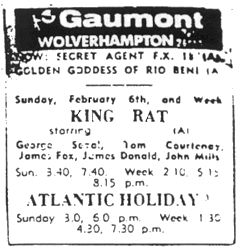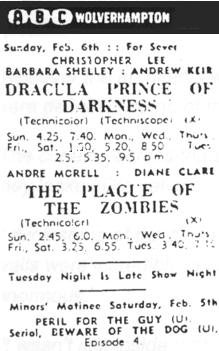The Regal continued to be successful in the immediate post-war years
with its local support showing little sign of wavering. It retained its
special luxury feeling and still remained the local flicks for
the people of Wednesfield. There was a special 21st Birthday presentation of the
'Student Prince'
on October 15th 1956 which was extremely well attended. However, the
same group which had demolished the Clifton at Failings Park so
suddenly, Newbold Securities, began to negotiate for the Regal to
follow the same fate! Like the Clifton, the end came very quickly. On
March 17th 1962, 'Naked Edge' starring
Gary Cooper was the final film to be shown at the Regal. There were
demands from the local community for a reprieve but within weeks the
cinema building was demolished. It was replaced by a Fine Fare (now
Solo) Supermarket.
In Bilston, the 50's produced a further series of changes to the
local cinemas. The Alhambra's lease passed into the hands of Ken
Woodroffe and his wife Doris who set about a major
refurbishment of the cinema. They hired Modernisation Ltd. to
carry out the work and had a Western Electric sound system installed.
There were still major problems for the cinema, like regular flooding,
but in general the Alhambra managed to survive the 50's quite well. It
was in the 60's that the Woodroffes had to resort to Bingo and Asian
films in an attempt to survive.
By 1964 the Woodroffes had given up the battle to provide regular
presentations and they relinquished the lease. The cinema remained open
for the screening of Asian films on a part-time basis. In 1982 an
application was made for the cinema building to become a clothes shop.
It is now part of Kwik Save Supermarket.
Wood's Palace had become the Odeon and had been successful during the
war with stage shows and regular showings of the major films of the
period. This situation continued into the 50's. In 1957 the Rank
Organisation, the owners of the Odeon circuit, introduced a new
automatic projection system into the cinema and enlarged the operating
facilities. However, this expenditure did not bode very well for the
Odeon's future for in 1964 it was announced that the cinema was to
close. On February 22nd 1964, 'Heaven's Above'
starring Peter Sellers was the last film to be shown at the cinema.
Within one month the building had been transformed by Top Rank Bingo!
In 1971 the freehold on the property was
sold to the Hutchinson Group, the operators of Surewin
Bingo. Although it did not remain part of the same combine, the
building continued to be one of Bilston's principal Bingo venues. The
premises are currently the Imperial Social Club.
The Savoy seemed to plod on through the 50's. In 1957 the lease
held by C.S. Joseph ended and it passed back to the Wood family. In July
1959 it was put up for sale by
Reay Wood, the son of Thomas Wood. It was sold in 1962 and
demolished to become a part of the Tesco Supermarket.
What of Wolverhampton's super cinemas during this period?
The Gaumont, like the other super-cinemas, enjoyed a very successful
wartime period and it probably expected that a similar situation would
continue long after the war.
 |
During the 1950's there were a number of attempts by
the management of the cinema to obtain a licence for the showing of
live entertainment which was both successful and unsuccessful,
according to the feelings of the licensing magistrates or the degree
of opposition from the Grand Theatre. During those successful
periods, the Gaumont featured a range of popular artists including
Bill Haley, Little Richard, Cliff Richard and the Beatles (both pre
and post Beatlemania). In the 1960's the Gaumont had a number of
late night film shows featuring some of the classics of the cinema
and quite regular Saturday morning matinees in an attempt to
increase audiences. |
However, by the early 70's and a continuing decline in
audiences it became quite clear that the Rank Organisation, which
controlled both the Gaumont and the Odeon, would be unlikely to keep
both town centre cinemas open. Most Wulfrunians expected the Gaumont, as
it was the larger and more impressive of the cinemas, to remain open.
In 1973 Rank announced that the Odeon was to be tripled. This meant
the end for the Gaumont! On November 10th 1973 the last complete
performance took place with the showing of 'The Great Caruso'
starring Mario Lanza and the classic 'Singing in the
Rain' starring Gene Kelly. In 1974 the building was
demolished. It was replaced ultimately by Allied Carpets.
It is now the site of Wilkinson's
General Stores and Curves Fitness Studio. The building
virtually covers the exact ground space of the former cinema.
The Odeon experienced a
very similar history to the Gaumont during the 50's and 60's, although
it was definitely the major venue for Saturday morning matinees (having
started matinees in August 1944).
The cinema celebrated it's 40th birthday in 1977 with
the showing of a whole series of cinema classics. This was four years
after the cinema had been tripled by Rank. The practice of
increasing (doubling/tripling) the number of screens in a cinema had
begun at the start of the 70's. The Odeon was the first example in the
town.
When Rank decided that the Gaumont would close and the Odeon remain
open, the decision to subdivide the cinema seemed logical. The old Odeon
closed in August 1973 and reopened with three screens on October
7th 1973. The new arrangements involved Screen 1 with 622 seats (the
former circle), Screen 2 with 96 seats and Screen 3 with 111 seats. The
first films to be shown at the new Odeon were 'Live and Let Die'
(1),
'Fist of Fury' (2) and 'Sleuth' (3).
The tripling of the Odeon did not prevent the cinema becoming caught
up in the general withdrawal of the Rank Organisation from cinema and on
June 4th 1983 the Odeon showed its final programme of films. The last
films were 'Boys in Blue'
starring Cannon & Ball, 'Table for Five'
starring Jon Voight and 'Nutcracker' starring
Joan Collins. The cinema was converted for Bingo by Top Rank.
It officially opened on September 9th 1983. It is still one of the
town's major Bingo venues.
The third of the town's super cinemas, the Savoy, had opened on
December 20th 1937 with the films 'Let's Make a Night of
It' with Buddy Rogers and 'Last Train from Madrid'
with Lew Ayres and Dorothy Lamour. Like the other town cinemas the Savoy
was very successful during the war and was still drawing the crowds in
the years immediately after the war. In 1948 the cinema began its own
ABC Minors Club.
| In December 1960 the cinema became known as the
ABC rather than the Savoy, although many Wulfrunians continued
to use the original name for the cinema. In February 1969 ABC was
taken over by EMI (Electrical & Musical Industries) and the
new owners set about redeveloping their cinemas. In
1974 EMI decided to triple the ABC cinema, in
direct competition to the Odeon. On May 13th 1974 the newly tripled
ABC opened. There were three screens with 590, 127 and 97 seats
respectively. When the Odeon closed as a cinema in 1983, the ABC
remained as the only cinema in the town. By the end of
1986 EMI had become Thorn EMI and the
new company had sold out its interest in the cinema chain to the
American company, Cannon. As a direct product of the
change the ABC now became the Cannon cinema. However, the new
cinema (at least in name) did not prevent the continuing fall in
audience figures. |
 |
On October 17th 1991, the Cannon closed. The final
programme of films was 'Jacob's Ladder'
(Screen 1) starring Tim Robbins, 'Robin Hood, Prince of
Thieves' (Screen 2) starring Kevin Costner and 'Out For
Justice' (Screen 3) starring Steven Seagal.
The building remained
derelict until this year (1996) when a redevelopment programme began.
The intention is to develop the premises into a leisure and shopping
complex (with cinema facilities) called the Metro Link Centre
with a new Midland Metro Station.
The closure of the Cannon did not mean that the town had no
cinema. In 1991 the Light House Cinema opened as part of the
Light House development at the former Chubb/Baelz building in
Fryer Street. The cinema has two screens and shows many of the more
popular films of the day as well as some of the minority interest films.
There are currently plans under consideration for the
development of a Multiplex cinema in the town. Two sites have been
proposed for the new cinema, one near to the former Low Level Station
and one in Wednesfield. It remains to be seen which, if either, is
selected, although at the time of writing the Wednesfield Bentley Bridge
seems the more likely choice of site for the new cinema complex.
 |
|
 |
Next
Page |
|
Contents |
|

























